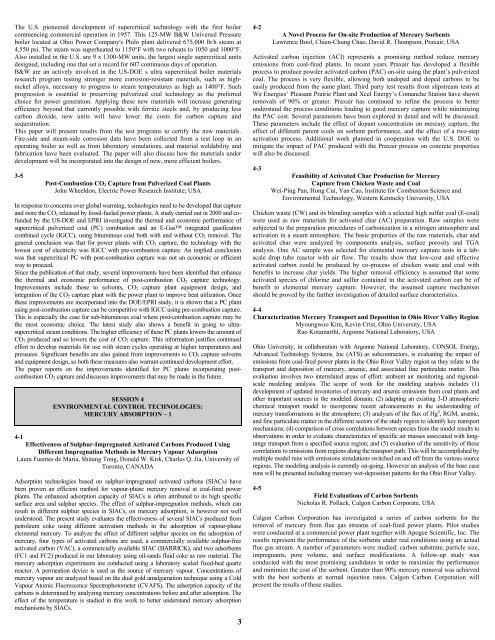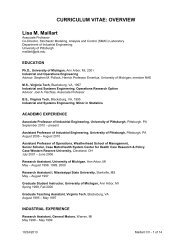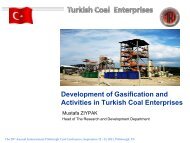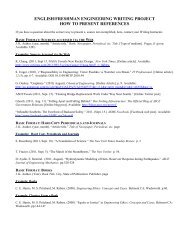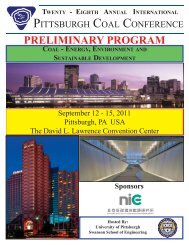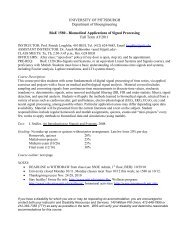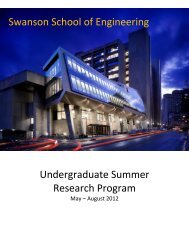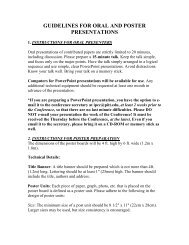Abstract Booklet 2006 - Swanson School of Engineering - University ...
Abstract Booklet 2006 - Swanson School of Engineering - University ...
Abstract Booklet 2006 - Swanson School of Engineering - University ...
Create successful ePaper yourself
Turn your PDF publications into a flip-book with our unique Google optimized e-Paper software.
The U.S. pioneered development <strong>of</strong> supercritical technology with the first boiler<br />
commencing commercial operation in 1957. This 125-MW B&W Universal Pressure<br />
boiler located at Ohio Power Company's Philo plant delivered 675,000 lb/h steam at<br />
4,550 psi. The steam was superheated to 1150°F with two reheats to 1050 and 1000°F.<br />
Also installed in the U.S. are 9 x 1300-MW units, the largest single supercritical units<br />
designed, including one that set a record for 607 continuous days <strong>of</strong> operation.<br />
B&W are an actively involved in the US-DOE s ultra supercritical boiler materials<br />
research program testing stronger more corrosion-resistant materials, such as highnickel<br />
alloys, necessary to progress to steam temperatures as high as 1400°F. Such<br />
progression is essential to preserving pulverized coal technology as the preferred<br />
choice for power generation. Applying these new materials will increase generating<br />
efficiency beyond that currently possible with ferritic steels and, by producing less<br />
carbon dioxide, new units will have lower the costs for carbon capture and<br />
sequestration.<br />
This paper will present results from the test programs to certify the new materials.<br />
Fire-side and steam-side corrosion data have been collected from a test loop in an<br />
operating boiler as well as from laboratory simulations, and material weldability and<br />
fabrication have been evaluated. The paper will also discuss how the materials under<br />
development will be incorporated into the design <strong>of</strong> new, more efficient boilers.<br />
3-5<br />
Post-Combustion CO 2 Capture from Pulverized Coal Plants<br />
John Wheeldon, Electric Power Research Institute; USA<br />
In response to concerns over global warming, technologies need to be developed that capture<br />
and store the CO 2 released by fossil-fueled power plants. A study carried out in 2000 and c<strong>of</strong>unded<br />
by the US-DOE and EPRI investigated the thermal and economic performance <strong>of</strong><br />
supercritical pulverized coal (PC) combustion and an E-Gas integrated gasification<br />
combined cycle (IGCC), using bituminous coal both with and without CO 2 removal. The<br />
general conclusion was that for power plants with CO 2 capture, the technology with the<br />
lowest cost <strong>of</strong> electricity was IGCC with pre-combustion capture. An implied conclusion<br />
was that supercritical PC with post-combustion capture was not an economic or efficient<br />
way to proceed.<br />
Since the publication <strong>of</strong> that study, several improvements have been identified that enhance<br />
the thermal and economic performance <strong>of</strong> post-combustion CO 2 capture technology.<br />
Improvements include those to solvents, CO 2 capture plant equipment design, and<br />
integration <strong>of</strong> the CO 2 capture plant with the power plant to improve heat utilization. Once<br />
these improvements are incorporated into the DOE/EPRI study, it is shown that a PC plant<br />
using post-combustion capture can be competitive with IGCC using pre-combustion capture.<br />
This is especially the case for sub-bituminous coal where post-combustion capture may be<br />
the most economic choice. The latest study also shows a benefit in going to ultrasupercritical<br />
steam conditions. The higher efficiency <strong>of</strong> these PC plants lowers the amount <strong>of</strong><br />
CO 2 produced and so lowers the cost <strong>of</strong> CO 2 capture. This information justifies continued<br />
effort to develop materials for use with steam cycles operating at higher temperatures and<br />
pressures. Significant benefits are also gained from improvements to CO 2 capture solvents<br />
and equipment design, so both these measures also warrant continued development effort.<br />
The paper reports on the improvements identified for PC plants incorporating postcombustion<br />
CO 2 capture and discusses improvements that may be made in the future.<br />
SESSION 4<br />
ENVIRONMENTAL CONTROL TECHNOLOGIES:<br />
MERCURY ABSORPTION – 1<br />
4-1<br />
Effectiveness <strong>of</strong> Sulphur-Impregnated Activated Carbons Produced Using<br />
Different Impregnation Methods in Mercury Vapour Adsorption<br />
Laura Fuentes de Maria, Shitang Tong, Donald W. Kirk, Charles Q. Jia, <strong>University</strong> <strong>of</strong><br />
Toronto, CANADA<br />
Adsorption technologies based on sulphur-impregnated activated carbons (SIACs) have<br />
been proven an efficient method for vapour-phase mercury removal at coal-fired power<br />
plants. The enhanced adsorption capacity <strong>of</strong> SIACs is <strong>of</strong>ten attributed to its high specific<br />
surface area and sulphur species. The effect <strong>of</strong> sulphur-impregnation methods, which can<br />
result in different sulphur species in SIACs, on mercury adsorption, is however not well<br />
understood. The present study evaluates the effectiveness <strong>of</strong> several SIACs produced from<br />
petroleum coke using different activation methods in the adsorption <strong>of</strong> vapour-phase<br />
elemental mercury. To analyze the effect <strong>of</strong> different sulphur species on the adsorption <strong>of</strong><br />
mercury, four types <strong>of</strong> activated carbons are used, a commercially available sulphur-free<br />
activated carbon (VAC), a commercially available SIAC (BARRICK), and two adsorbents<br />
(FC1 and FC2) produced in our laboratory using oil-sands fluid coke as raw material. The<br />
mercury adsorption experiments are conducted using a laboratory scaled fixed-bed quartz<br />
reactor. A permeation device is used as the source <strong>of</strong> mercury vapour. Concentrations <strong>of</strong><br />
mercury vapour are analyzed based on the dual gold amalgamation technique using a Cold<br />
Vapour Atomic Fluorescence Spectrophotometer (CVAFS). The adsorption capacity <strong>of</strong> the<br />
carbons is determined by analyzing mercury concentrations before and after adsorption. The<br />
effect <strong>of</strong> the temperature is studied in this work to better understand mercury adsorption<br />
mechanisms by SIACs.<br />
3<br />
4-2<br />
A Novel Process for On-site Production <strong>of</strong> Mercury Sorbents<br />
Lawrence Bool, Chien-Chung Chao, David R. Thompson, Praxair, USA<br />
Activated carbon injection (ACI) represents a promising method reduce mercury<br />
emissions from coal-fired plants. In recent years Praxair has developed a flexible<br />
process to produce powder activated carbon (PAC) on-site using the plant’s pulverized<br />
coal. The process is very flexible, allowing both undoped and doped carbons to be<br />
easily produced from the same plant. Third party test results from slipstream tests at<br />
We Energies’ Pleasant Prairie Plant and Xcel Energy’s Comanche Station have shown<br />
removals <strong>of</strong> 90% or greater. Praxair has continued to refine the process to better<br />
understand the process conditions leading to good mercury capture while minimizing<br />
the PAC cost. Several parameters have been explored in detail and will be discussed.<br />
These parameters include the effect <strong>of</strong> dopant concentration on mercury capture, the<br />
effect <strong>of</strong> different parent coals on sorbent performance, and the effect <strong>of</strong> a two-step<br />
activation process. Additional work planned in cooperation with the U.S. DOE to<br />
mitigate the impact <strong>of</strong> PAC produced with the Praxair process on concrete properties<br />
will also be discussed.<br />
4-3<br />
Feasibility <strong>of</strong> Activated Char Production for Mercury<br />
Capture from Chicken Waste and Coal<br />
Wei-Ping Pan, Hong Cui, Yan Cao, Institute for Combustion Science and<br />
Environmental Technology, Western Kentucky <strong>University</strong>, USA<br />
Chicken waste (CW) and its blending samples with a selected high sulfur coal (E-coal)<br />
were used as raw materials for activated char (AC) preparation. Raw samples were<br />
subjected to the preparation procedures <strong>of</strong> carbonization in a nitrogen atmosphere and<br />
activation in a steam atmosphere. The basic properties <strong>of</strong> the raw materials, char and<br />
activated char were analyzed by components analysis, surface porosity and TGA<br />
analysis. One AC sample was selected for elemental mercury capture tests in a labscale<br />
drop tube reactor with air flow. The results show that low-cost and effective<br />
activated carbon could be produced by co-process <strong>of</strong> chicken waste and coal with<br />
benefits to increase char yields. The higher removal efficiency is assumed that some<br />
activated species <strong>of</strong> chlorine and sulfur contained in the activated carbon can be <strong>of</strong><br />
benefit to elemental mercury capture. However, the assumed capture mechanism<br />
should be proved by the further investigation <strong>of</strong> detailed surface characteristics.<br />
4-4<br />
Characterization Mercury Transport and Deposition in Ohio River Valley Region<br />
Myoungwoo Kim, Kevin Crist, Ohio <strong>University</strong>, USA<br />
Rao Kotamarthi, Argonne National Laboratory, USA<br />
Ohio <strong>University</strong>, in collaboration with Argonne National Laboratory, CONSOL Energy,<br />
Advanced Technology Systems, Inc (ATS) as subcontractors, is evaluating the impact <strong>of</strong><br />
emissions from coal-fired power plants in the Ohio River Valley region as they relate to the<br />
transport and deposition <strong>of</strong> mercury, arsenic, and associated fine particulate matter. This<br />
evaluation involves two interrelated areas <strong>of</strong> effort: ambient air monitoring and regionalscale<br />
modeling analysis. The scope <strong>of</strong> work for the modeling analysis includes (1)<br />
development <strong>of</strong> updated inventories <strong>of</strong> mercury and arsenic emissions from coal plants and<br />
other important sources in the modeled domain; (2) adapting an existing 3-D atmospheric<br />
chemical transport model to incorporate recent advancements in the understanding <strong>of</strong><br />
mercury transformations in the atmosphere; (3) analyses <strong>of</strong> the flux <strong>of</strong> Hg 0 , RGM, arsenic,<br />
and fine particulate matter in the different sectors <strong>of</strong> the study region to identify key transport<br />
mechanisms; (4) comparison <strong>of</strong> cross correlations between species from the model results to<br />
observations in order to evaluate characteristics <strong>of</strong> specific air masses associated with longrange<br />
transport from a specified source region; and (5) evaluation <strong>of</strong> the sensitivity <strong>of</strong> these<br />
correlations to emissions from regions along the transport path. This will be accomplished by<br />
multiple model runs with emissions simulations switched on and <strong>of</strong>f from the various source<br />
regions. The modeling analysis is currently on-going. However an analysis <strong>of</strong> the base case<br />
runs will be presented including mercury wet-deposition patterns for the Ohio River Valley.<br />
4-5<br />
Field Evaluations <strong>of</strong> Carbon Sorbents<br />
Nicholas R. Pollack, Calgon Carbon Corporate, USA<br />
Calgon Carbon Corporation has investigated a series <strong>of</strong> carbon sorbents for the<br />
removal <strong>of</strong> mercury from flue gas streams <strong>of</strong> coal-fired power plants. Pilot studies<br />
were conducted at a commercial power plant together with Apogee Scientific, Inc. The<br />
results represent the performance <strong>of</strong> the sorbents under real conditions using an actual<br />
flue gas stream. A number <strong>of</strong> parameters were studied: carbon substrate, particle size,<br />
impregnants, pore volume, and surface modifications. A follow-up study was<br />
conducted with the most promising candidates in order to maximize the performance<br />
and minimize the cost <strong>of</strong> the sorbent. Greater than 90% mercury removal was achieved<br />
with the best sorbents at normal injection rates. Calgon Carbon Corporation will<br />
present the results <strong>of</strong> these studies.


